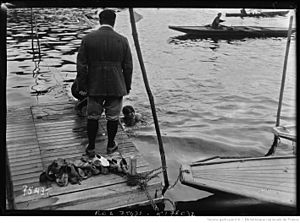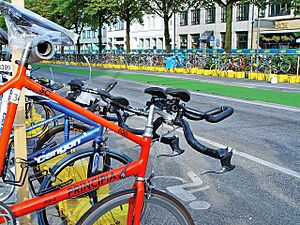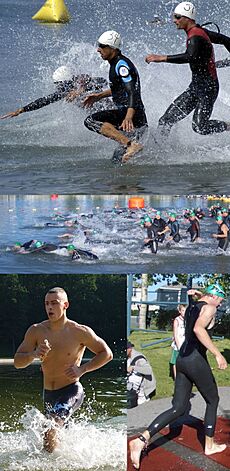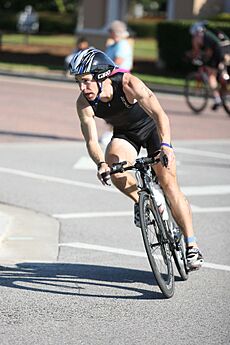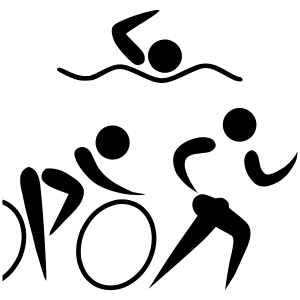Triathlon facts for kids

The three typical components of triathlon: swimming, cycling, and running.
|
|
| Highest governing body | World Triathlon |
|---|---|
| First played | 1920s |
| Characteristics | |
| Contact | No |
| Mixed-sex | Yes, separate competitions & mixed relays |
| Type | Endurance sport |
| Equipment | Triathlon equipment |
| Presence | |
| Country or region | Worldwide |
| Olympic | 2000 – present |
| Paralympic | Paratriathlon, 2016 – present |
| World Games | 1989 (invitational) – 1993 |
A triathlon is a challenging race that combines three different sports. Athletes first swim, then bike, and finally run. They do all three parts one after another without stopping. The goal is to finish the whole race in the fastest time.
The name "triathlon" comes from Greek words. "Treis" means three, and "athlos" means competition. So, it literally means "three competitions."
This exciting sport started in the late 1970s in Southern California. Since then, many different types of triathlons have been created. Athletes train hard to build their endurance, strength, and speed. They need to practice each sport a lot, plus do special workouts that combine them.
Contents
The History of Triathlon
It's a bit tricky to pinpoint exactly when triathlon began. Some historians believe it started in France in the early 1900s. Back then, people organized multi-sport events with different names.
One of the earliest recorded events was in 1901 in Joinville-le-Pont, France. It was called "Les Trois Sports" (The Three Sports). This race included running, cycling, and canoeing. By 1921, the canoeing part was replaced with swimming, making it more like today's triathlon. This race involved a 3 km run, a 12 km bike ride, and swimming across the Marne River.
Other similar races appeared in France during the 1920s and 1930s. However, there were no standard rules, and triathlon remained a small sport for many years.
How Modern Triathlon Began
The first modern triathlon, with swimming, biking, and running, happened on September 25, 1974. It took place at Mission Bay, San Diego, California. Two members of the San Diego Track Club, Jack Johnstone and Don Shanahan, organized it.
They wanted a race that focused equally on all three parts. They named it the "Mission Bay Triathlon," using the Greek "tri" for three and "athlon" for competition. They didn't know about the earlier French events and thought their idea was new!
The 1974 race started with a 3-mile run, followed by a 5-mile bike ride. Then, participants swam across Mission Bay, ran barefoot, swam again, and finished with a final swim and climb up a dirt bank. Many participants were not strong swimmers, so Johnstone's 13-year-old son helped as a lifeguard. Forty-six people entered, mostly from local running clubs. Two of these participants, Judy and John Collins, later created the famous Hawaii Ironman race.
Triathlon Spreads to Europe
The first European triathlon was held in Pilsen, Czechoslovakia, in 1980. Other countries like the Netherlands, Belgium, and West Germany soon followed. However, these events didn't get much media attention at first.
In 1982, a big event called the Nice Triathlon was organized in Nice, France. It included a 1500-meter swim, a 100 km bike ride, and a full marathon run. A TV show about the Nice Triathlon introduced the sport to many people. Even though some athletes ended up in the hospital because of the cold water, the sport started to become popular. Throughout the 1980s, the Nice Triathlon and the Hawaii Ironman were the two most important long-distance races.
In 1985, the European Triathlon Union (ETU) was formed. Its goal was to bring together triathlon groups in different European countries. This was also a step towards creating a worldwide organization for the sport.
Creating a Global Triathlon Group
The first attempt to create a global triathlon group was called the Triathlon Federation International (TFI). It had only 22 members, mostly from Europe. But there were disagreements, and the TFI didn't fully succeed.
Around the same time, Les McDonald from Canada talked with Juan Antonio Samaranch, who was the head of the International Olympic Committee. Samaranch wanted to add triathlon to the Olympic Games quickly. He suggested it could be a demonstration sport at the 1992 Barcelona Olympics. However, this would mean triathlon would be part of another sport's organization, which many triathletes didn't like.
So, an Olympic working committee for triathlon was formed. In February 1989, this committee worked on rules for a new organization. On April 1, 1989, 30 national groups met in Avignon, France. They officially created the International Triathlon Union (ITU) and elected Les McDonald as its first president. Avignon also hosted the first World Championship.
In 1991, the IOC officially recognized the ITU as the main governing body for triathlon. In 1994, triathlon was added to the Olympic program as a medal sport for the Sydney Games in 2000.
Triathlon Organizations
The World Triathlon (formerly the International Triathlon Union) was founded in 1989. Its main goal was to get triathlon into the Olympics. Today, World Triathlon organizes races like the World Triathlon Series and World Triathlon Cup. They crown world champions each year for professional athletes, junior athletes, and age-group athletes (amateurs grouped by age). In World Triathlon races, athletes are allowed to "draft" (ride closely behind another cyclist to save energy) during the bike leg.
The World Triathlon Corporation (WTC) is a private company that organizes the famous Ironman and Ironman 70.3 races. These races are qualifiers for their own annual World Championships. The Ironman World Championship is held every October in Kailua-Kona, Hawaii. The Ironman 70.3 World Championship moves to a different location each September. The names "Ironman" and "Iron" are owned by WTC. This means other long-distance races cannot use these names.
Many other organizations exist, from small local clubs to large companies like the Challenge Family, which puts on long-distance events worldwide. The International Ultra-Triathlon Association (IUTA) governs Ultratriathlon, which are races even longer than Ironman. Also, most countries have their own triathlon organizations that oversee races and help athletes qualify for events like the Olympics.
The Professional Triathletes Organisation (PTO) started in 2016. It's owned by the athletes themselves and focuses on promoting professional triathletes who compete in non-drafting races. In 2022, the PTO launched the PTO Tour, a series of big professional races with large prize money.
Working Together: ITU and WTC
For a while, the ITU and WTC had some disagreements about rules and who had authority. This led to conflicts, especially in 2005, when the ITU asked national triathlon groups to stop approving WTC events. The ITU felt that WTC was trying to create its own federation and wasn't following rules like those from the World Anti-Doping Agency (WADA).
However, in 2006, the ITU changed its mind after an agreement was reached. This agreement meant WTC races would follow WADA rules and have drug testing for elite athletes.
Since 2008, the ITU and WTC have been working together more. In 2017, they signed an agreement to:
- Work together on anti-doping efforts.
- Confirm the ITU as the main international group for triathlon.
- Create a single set of rules for different race distances.
- Work together to help the sport grow.
Triathlon Race Formats
Triathlons come in many different lengths, from very short races for kids to extremely long ones. Here are some common distances:
| Name | Swim | Bicycle | Run | Notes |
|---|---|---|---|---|
| Kids of Steel | 100–750 m (110–820 yd) |
5–15 km (3.1–9.3 mi) |
1–5 km (0.62–3.11 mi) |
Distances change based on the athlete's age. |
| Super Sprint | 400 m (0.25 mi) |
10 km (6.2 mi) |
2.5 km (1.6 mi) |
Shorter than a sprint race, often uses swimming pools. |
| Sprint | 750 m (0.47 mi) |
20 km (12 mi) |
5 km (3.1 mi) |
Half the Olympic distance. |
| Olympic | 1.5 km (0.93 mi) |
40 km (25 mi) |
10 km (6.2 mi) |
Also called "international distance" or "standard course." |
| Triathlon 70.3 | 1.9 km (1.2 mi) |
90 km (56 mi) |
21.1 km (13.1 mi) |
Also known as "half-ironman." The "70.3" is the total miles. |
| Triathlon 140.6 | 3.9 km (2.4 mi) |
181 km (112 mi) |
42.2 km (26.2 mi) |
Also known as "full distance" or "Ironman Triathlon." The "140.6" is the total miles. |
Races longer than the full distance are called ultratriathlons. Race organizers can also create unique distances to fit their location or attract specific athletes.
The Olympic distance (1.5 km swim, 40 km bike, 10 km run) was created in the mid-1980s by race director Jim Curl. Sprint triathlons are the most common distance in the United States.
There are also "111" and "222" events. The 111 distance is a 1 km swim, 100 km bike, and 10 km run, totaling 111 km. The 222 distance is double that.
Most triathlons are individual races. However, there are also relay triathlons where a team of athletes takes turns. Each person does one part of the swim, bike, or run. The World Triathlon Mixed Relay Championships and the Olympic mixed relay involve teams of two men and two women.
How a Triathlon Race Works
To join a triathlon, athletes usually sign up beforehand. They receive a race number, a colored swim cap, and a timing chip. They also get information about the course, rules, and any important details. For big events like an Ironman, athletes might set up their bikes in the transition area a day or two before the race.
On race day, athletes get a spot in the "transition area." This is where they keep their bike, shoes, and other gear. In some races, there are two transition areas: one for changing from swim to bike, and another for changing from bike to run.
Athletes are usually divided into professional and amateur groups. Most triathletes are amateurs, often called "age groupers." They compete against others of their same gender and age group (e.g., 15-19, 20-24). Some races also have categories for heavier athletes, like "Clydesdale" for men over 220 lbs and "Athena" for women over 165 lbs.
Races can start in different ways:
- Mass start: All athletes begin swimming at the same time.
- Wave start: Smaller groups of athletes start every few minutes, often based on age or expected swim time. This is common in shorter races with many participants.
- Individual time trial starts: Athletes enter the water one by one, a few seconds apart.
The swim part can be in a lake, ocean, or swimming pool. In open water, athletes swim around marked buoys. After the swim, racers exit the water and go to the transition area. Here, they quickly change from swim gear to bike gear. Many triathletes wear special clothing that works for both swimming and cycling. This helps them change faster by just removing their wetsuit, cap, and goggles, and putting on a helmet and bike shoes. Some even attach their bike shoes to their pedals to save time.
The cycling part usually takes place on public roads. In smaller races, roads might not be closed to cars, but traffic helpers are often present. The bike course usually finishes back at the same transition area. Athletes rack their bikes and quickly change into running shoes for the final part. The run usually ends at a separate finish line.
During the bike and run parts, "aid stations" provide water and energy drinks. In longer races, aid stations might also offer food like energy bars, fruit, or soup. After finishing the race, athletes can get more refreshments.
Rules of Triathlon
While rules can vary slightly between different organizations (like World Triathlon or USA Triathlon), some basic rules are universal. Triathlon is usually an individual sport. Athletes compete against the course and the clock. They cannot get help from anyone outside the race, except for race volunteers who give out food and water.
Triathlons are timed in five parts:
- Swim time (from start to the first transition).
- T1 time (the first transition, from swim to bike).
- Bike time (from the start of cycling to the end).
- T2 time (the second transition, from bike to run).
- Run time (from the start of running to the finish line).
Race results usually show each of these times, plus the total time.
Other rules cover equipment. For example, wetsuits are allowed in the swim if the water is cold (usually below 26°C or 78.1°F). Using flippers or other swim aids is not allowed and can lead to disqualification.
For the bike leg, athletes must wear their helmet before touching their bike and keep it on until they have dismounted. The bike must be powered only by human force. Athletes cannot push off with their hands. There's also a clear line where athletes can start riding their bike out of transition. Crossing this line too early can result in a time penalty.
Other penalties can be given for things like "drafting" (riding too close behind another cyclist) in races where it's not allowed, improper passing, littering, or unsportsmanlike behavior.
Triathlon and Fitness
Many people do triathlon to get fit or stay healthy. Training for swimming, biking, and running helps improve your heart and lung health. Triathletes also tend to have fewer injuries than people who only run, because swimming and cycling are lower impact sports.
Triathletes spend many hours training. They focus on improving their aerobic capacity (how well their body uses oxygen), lactate threshold (how long they can exercise intensely), and efficiency in each sport. The variety of training helps prevent injuries that can come from doing just one activity. Triathletes also do other exercises like yoga, pilates, and weight training to help their overall fitness.
Swimming in Triathlon
Triathletes often swim differently from other swimmers. They try to use their legs less to save energy for the bike and run. They might also change their swim stroke to handle choppy water and save energy during a long swim.
Most triathlons have open-water swims, not pools. Athletes need to "sight" by lifting their head to look for buoys or landmarks to stay on course. A special stroke helps them do this without losing speed.
Because open water can be cold, many triathletes wear special wetsuits. These wetsuits are designed to help with buoyancy (floating) and warmth. They are allowed in races if the water temperature is 26°C (78.1°F) or less. Some races might ban wetsuits if the water is too warm to prevent overheating.
Cycling in Triathlon
Triathlon cycling can be different from professional bike racing. In some races (like Ironman), drafting is not allowed. This means cyclists must keep a certain distance from each other, making it more like an individual time trial. In other races (like World Triathlon Series), drafting is allowed, and cyclists can ride in groups (pelotons) to save energy.
Triathlon bikes are often designed to be very aerodynamic. They have special handlebars called "aero-bars" and aerodynamic wheels. The bike's design also helps save leg muscles for the run. Towards the end of the bike leg, triathletes often pedal faster (higher cadence) to keep their leg muscles loose for the run.
Running in Triathlon
The biggest difference about running in a triathlon is that it happens after swimming and cycling. Many muscles are already tired. First-time triathletes are often surprised by how weak their legs feel and how much slower they run. To prepare for this, triathletes do "brick" workouts, which involve cycling immediately followed by running.
Transition: The Fourth Discipline
The change between sports happens in the "transition area." This is where athletes set up their bikes, running shoes, and other gear.
- T1 (Transition 1) is the change from swimming to cycling.
- T2 (Transition 2) is the change from cycling to running.
Most races have one main transition area for both T1 and T2. The time spent in transition counts towards the athlete's total race time. Being fast and smooth in transition can make a big difference in the final results. Because it's so important, transition is often called the "fourth discipline" of triathlon.
Notable Triathlon Events
Thousands of triathlons happen worldwide each year. Some are very famous because of their long history or tough courses.
World Triathlon Organized Events
- World Triathlon Series
- World Triathlon Cup
- World Triathlon Long Distance Championships
- World Triathlon Mixed Relay Championships
Triathlon at the Olympics and Paralympics
Triathlon became an Olympic sport at the Sydney Games in 2000. It uses the Olympic Distance (1.5 km swim, 40 km bike, 10 km run). A mixed relay event was added at the Tokyo Games in 2021.
Paratriathlon at the Summer Paralympics (triathlon for athletes with physical disabilities) debuted at the 2016 Summer Paralympics in Rio de Janeiro. Athletes compete in different categories based on their physical impairments.
Other major multi-sport games that include triathlon:
- Triathlon at the African Games
- Triathlon at the Asian Games
- Triathlon at the Commonwealth Games
- Triathlon at the Pan American Games
Other Famous Triathlon Races
- Hawaii Ironman World Championship, Kona, Hawaii. This race started in 1978 and is known for its extremely hot temperatures (over 43°C or 110°F) and strong cross-winds. Only qualified athletes can enter this world championship race.
- Nice Triathlon, Nice, France. This race was very important in the 1980s, alongside the Hawaii Ironman. It was known for its long distances (4 km swim, 120 km bike, 30 km run).
- Enduroman Arch to Arc. This is a super-long 289-mile triathlon from London to Paris. It involves running from London to Dover, swimming the English Channel, and then cycling from Calais to Paris. Very few people have completed it.
- Escape from Alcatraz, San Francisco, California. This unique race starts with a 1.5-mile swim in the cold San Francisco Bay from Alcatraz Island. It's followed by a hilly 18-mile bike ride and an 8-mile run, which includes a tough 400-step climb called the "Sand Ladder."
- Norseman Extreme Triathlon, Norway. This Ironman-distance race starts with a swim in a cold fjord and finishes on top of a mountain. It's famous for its low temperatures and huge elevation gain.
Different Kinds of Triathlons
Besides the standard swim-bike-run format, there are many variations:
- Aquabike: Only swimming and cycling.
- Aquathlon: Only swimming and running.
- Swimrun: Alternating swimming and running stages without stopping for transitions.
- Duathlon: Only cycling and running.
- Indoor triathlon: Uses a pool for swimming, a stationary bike, and an indoor track or treadmill for running.
- Cross triathlon: Involves swimming, mountain biking, and trail running. The XTERRA Triathlon series is an example.
- Xtreme Triathlon: Features cold water swimming, cycling with big climbs, and mountain trail running.
- Ultraman triathlon: A very long, three-day triathlon covering 320 miles in separate stages.
- Winter triathlon: Usually includes two events from cross-country skiing, mountain biking, or ice speed skating, followed by running.
- Aerothlon (Alpine Triathlon): An extreme triathlon with mountain running, mountain biking, and Paragliding.
See also
 In Spanish: Triatlón para niños
In Spanish: Triatlón para niños
- Ironman Triathlon
- Duathlon
- List of triathletes
- Pentathlon
- Quadrathlon
- Tetrathlon
- Triathlon equipment


